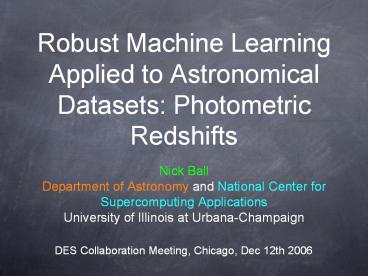Robust Machine Learning Applied to Astronomical Datasets: Photometric Redshifts PowerPoint PPT Presentation
1 / 20
Title: Robust Machine Learning Applied to Astronomical Datasets: Photometric Redshifts
1
Robust Machine Learning Applied to Astronomical
Datasets Photometric Redshifts
- Nick Ball
- Department of Astronomy and National Center for
Supercomputing Applications - University of Illinois at Urbana-Champaign
DES Collaboration Meeting, Chicago, Dec 12th 2006
2
Collaborators
- Laboratory for Cosmological Data Mining (LCDM) at
NCSA and UIUC Astronomy Robert Brunner, Adam
Myers, Natalie Strand, Stacey Alberts - Automated Learning Group, NCSA David Tcheng,
Xavier Llorà - LCDM is a top-20 user of NCSA supercomputing
resources
3
Photozs Quasars, Galaxies
- We apply instance-based learning to obtain
photometric redshifts for objects in the SDSS DR5
and GALEX GR2 - We use the Java environment Data to Knowledge and
the NCSA Xeon Linux supercomputing cluster
Tungsten - Here we present results for quasars, then
preliminary results for galaxies
4
Instance-Based Learning
- Memorize the positions in parameter space of each
training object - For new objects, calculate the weighted average
redshift of the k nearest neighbors - Most of the work is done in the latter stage
- Computationally intensive
5
Quasar Photozs
- We assign photozs to 55,746 SDSS DR5 quasars and
7,642 SDSS DR5GALEX GR2 quasars (i lt 19.1) - We use a CZR and compare it to instance-based
learning - We train on 80 and blind test on 20
- This gives blind testing samples of 11,149 for
SDSS and 1,528 for SDSSGALEX
6
SDSS CZR blind test 11,149 of 55,746 quasars
7
SDSS k-NN instance-based blind test 11,149 of
55,746 quasars
8
SDSSGALEX k-NN instance-based blind test 1,528
of 7,642 quasars
9
Galaxy Photozs
- We have assigned preliminary galaxy photozs to
SDSS DR5 Main galaxies (r lt 17.77) using a
decision tree - The RMS dispersion is 0.02
- This is similar to existing photozs for these
galaxies
10
SDSS DR5 Main galaxies
11
Next Steps
- Full PDFs incorporated into the machine learning
and output photozs - Assign photozs with PDFs to 200 million objects
in SDSS photoPrimary, as done for classification
into star-galaxy-neither by Ball et al. 2006a
(ApJ 650 497) - Use of (funded by NASA AISR) High Performance
Reconfigurable Computing (HPRC) in collaboration
with NCSA Innovative Systems Laboratory - Further multiwavelength training data
12
Conclusions
- We have assigned photozs to quasars and in the
SDSS DR5 and GALEX GR2 - We have assigned preliminary photozs to SDSS DR5
Main galaxies - We find that instance-based learning reduces the
incidence of catastrophic failures in quasar
photozs compared to CZR
13
- http//nball.astro.uiuc.edu
- Ball et al. 2006b, in preparation
- DES uploaded talks (extra slides)
14
Extra slides...
15
D2K
- We use the Java environment Data to Knowledge,
developed at NCSA - Modified to run on multiple Tungsten nodes and
multi-GB-sized datasets - D2K itineraries automate the data-mining process
- Many different algorithms are available
16
Text
D2K screenshot
17
NCSA Supercomputing
- Xeon Linux Cluster Tungsten
- 2,560 Intel IA-32 Xeon 3.2 GHz processors, 3 GB
memory/node - Peak performance 16.38 TF (9.819 TF sustained)
18
CZR, 3,814 SDSS EDR quasars, Weinstein et al.
2004 (ApJS 155 243)
19
Instance-based effect of number of nearest
neighbors and distance weighting
20
(No Transcript)

